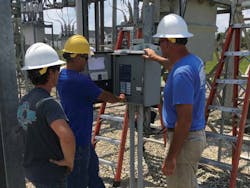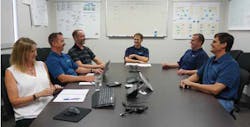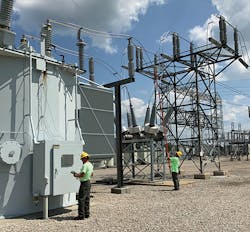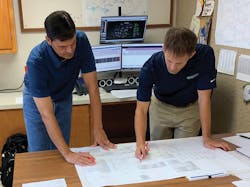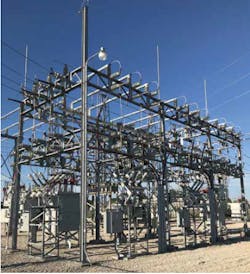Central Intelligence in the Electric Utility
As the regulatory, political and economic landscape of the utility industry continues to shift, building operational efficiencies into the business model cannot be overlooked. In today’s business climate, electric utilities must be nimble, innovative and member-focused to meet the challenges of this changing environment. Clinging to outdated processes, relying on antiquated systems, and failing to embrace technological advances can cripple an organization’s reliability and responsiveness. Additionally, with growing concerns about cybersecurity, a secure and robust system is paramount.
In recognizing its need for enhanced usability and tightened security, Central Electric Power Cooperative prioritized finding a more comprehensive asset management system that could be managed in-house. While cross collaboration is not a new concept, too often the idea gets dismissed, particularly among technical divisions. Central determined that successful planning, preparation and implementation would hinge on working collaboratively across engineering and information technology (IT) to find the right product to meet its needs.
Outdated Systems
An independent and locally owned electric generation and transmission (G&T) co-op, Central serves 26 counties in the mid-Missouri area of the U.S. With approximately 117 substations, ranging from 69 kV to 345 kV, and 1625 miles (2615 km) of transmission lines, Central delivers power to eight distribution co-ops covering a 22,000-sq mile (56,979-sq km) area. The utility has approximately 100 employees, of which only nine are substation technicians, referred to as electrician mechanics.
Central not only engineers its transmission system but also provides engineering services to the member-owner distribution co-ops. It seldom hires outside consultants or contractors for substation projects and, instead, does most of the engineering, design, procurement, construction and maintenance work in-house. Although this depth of expertise and ability is one of Central’s unique strengths, its outdated systems were becoming increasingly difficult to maintain and creating inefficiencies, particularly in the face of rapid growth. Over the last 20 years, Central’s service area has experienced significant expansion around Columbia, Lake of the Ozarks and the west side of St. Louis.
The resulting load growth within Central’s large geographical footprint presents logistical challenges. From the co-op’s headquarters in Jefferson City, it takes almost two hours to reach substations located on its eastern boundaries. While there are processes for inspection, monitoring and support of the system, an outdated IBM AS/400 was used for data storage. Introduced in the 1980s, this system had functional limitations in today’s environment.
Inspection Gaps
To minimize response time and keep an eye on the whole system, Central uses a hybrid approach for monitoring and dispatching. Four outlying switchmen — responsible for system care and maintenance — are assigned to specific geographic areas. These employees live in the middle of Central’s territory and start work every morning from their respective homes rather than at headquarters. On the other hand, the electrician mechanics report each morning to headquarters and are dispatched across the territory, where needed. Transmission system operators, commonly referred to as dispatchers, monitor the electrical system through the supervisory control and data acquisition (SCADA) system 24/7 to ensure all substations function correctly.
The AS/400 system housed an abundant amount of information but became challenging to maintain and lacked technical flexibility to integrate with field inspection and management. For example, monthly substation inspections by electrician mechanics depended on paper inspection forms that required in-office filing. Only significant problems were communicated to the superintendent. Switchmen followed a similar process for major concerns. They also logged minor incidents on a paper reporting form, but their remote work situation meant minor issues went unreported until they traveled to Central’s offices for important meetings. This process often left operational leadership unaware of minor problems, resulting in gaps and unintended oversight related to substation inspections.
Needs Assessment
With the full support of Central’s leadership and internal expertise to shepherd the process, the search for asset management software began. Aside from the apparent limitations of the existing system, additional factors drove the co-op’s decision making. Because of the significant amount of substation equipment maintenance, it was essential to keep pertinent information about all assets in a centralized database as well as have storage capacity to increase the data. As an example, some notes date back to the 1960s that provide details on a particular asset. And, while keeping that historical data might seem unimportant, this information sees continued use.
Central maintains three main pieces of equipment: transformers, breakers and reclosers. Each is on a five-year maintenance schedule. However, bus conductors, lightning arresters, instrument transformers, switches and many other substation components also are tracked. Especially for the inspection process, Central could see several immediate benefits in switching from paper to electronic reporting.
Following an internal needs assessment by a team made up of different departments, the process of researching vendors began. The utility had four requirements for a platform:
- Data entry
- Data analysis
- Maintenance/work planning
- System awareness.
A SMART Choice
Central’s technical team discovered Substation Maintenance & Asset Reliability Tracking (SMART), a robust inspection and asset management software designed and developed by MinMax Technologies. The SMART platform not only met the four fundamental requirements but also provided customization, a critical factor for Central. The ability to develop a centralized database was a key driver in software selection. SMART enabled this.
Currently, Central uses SMART to log all critical data on equipment, including serial number, installation date, manufacturer, model number, stock number and more, as well as notes spanning the equipment life cycle, from purchase order to disposal. It stores thousands of equipment details, automatically generates monthly substation checks and keeps track of resulting issues. SMART logs data from the inspection process and sends an email when complete, enabling key operations personnel timely viewing and the ability to address problems found. Because of SMART’s flexibility, Central continues to implement more uses within daily operational tasks, leading to improved efficiency throughout the organization.
SMART also streamlined Central’s reporting requirements for key partners and regulatory agencies. The co-op is one of six G&Ts that form Associated Electric Cooperative Inc. (AECI), which provides Central with economical, reliable wholesale power supply and support services. While Central was researching software solutions specific to its substation inspection process, AECI also needed an improved method to handle compliance reporting of North American Electric Reliability Corporation’s (NERC) FAC-008 standard. Implementing FAC-008 reporting was a considerable hurdle and a pressing need, and the MinMax team worked with AECI leadership to implement groupings for the standard.
With the SMART system, the facility rating feature enables member-owners, like Central, to send information quickly. Before this, Central and the AECI family relied on a large Excel document to note the limiting element in each group. With SMART, members now can group each facility with all related equipment that has a power or current rating. AECI can pull this data into its systems for real-time contingency analysis, planning studies and energy management. This process enables robust data analysis and timely updates — minutes instead of weeks. Not only does the SMART software help to meet NERC and SERC Reliability Corp. regulatory demands and other substation equipment maintenance requirements for batteries, transformers and relays, it also tracks SF6 gas quantities on the system.
Cross Collaboration
Successful implementation of this process boiled down to three major activities that required technical collaboration and expertise from the engineering and IT departments. Working in unison, these two divisions first identified and built a comprehensive asset database. Engineering staff then developed and promoted a set of actionable processes. Together, they applied the selected software, hardware and communication tools.
Key engineering and technology personnel worked in tandem to ensure exported equipment data from AS/400 was aligned correctly for import into the SMART system. First, data was imported into a test database to troubleshoot, where needed, before sending the data into the production database. In less than a week, 8000 pieces of equipment data were transferred from the AS/400 into SMART. Initially, Central’s IT and operations personnel had weekly meetings so the operations personnel could explain expectations from the field perspective and IT could relay back-end software functionality. By doing this, the team stayed on task, and everyone involved had a greater understanding of the project.
These collaborative efforts proved particularly beneficial when creating the production database and, ultimately, helped to ensure a smooth transition. When problems arose, the team developed solutions. Most importantly, the team had access to dedicated personnel at MinMax for support.
Technology transitions can challenge an organization, particularly when moving from a paper system. When the utility was ready to roll out the new system, it dedicated enough time and resources for training, using small-group tutorial sessions and mock trials. The electrician mechanics and switchmen practiced first in a test environment to navigate the software as it would be used in practice. Before switching to production, the entire crew, including engineering leadership, conducted a practice inspection at a substation. This effort paid dividends and helped to instill confidence among end users in the field.
One of the greatest transitions for employees was migrating from the AS/400 black screen to a vibrant web-based database management system. The tutorial sessions, simulations, product interface and customization eventually helped the utility to overcome any hesitancies.
On the Horizon
Having met initial priorities to migrate from paper to a dynamic, comprehensive database system, the focus is now on placing all five-year maintenance inspection forms and test reports in SMART. Additionally, plans to create service kits will begin once the IT department has the new accounting software fully implemented.
The creation of service kits is anticipated to be a lengthy process because all equipment will be itemized by type. However, Central believes ultimately it will result in significant time savings for field personnel to have inventory data readily available.
Currently, the AS/400 system still is used to inventory all equipment, accessories and parts, which coordinates accessories and parts with each piece of equipment. Because Central’s new accounting software does not support a tree hierarchy to group equipment, accessories and parts, MinMax has customized the SMART software to provide that functionality. Now, under the nameplate data tab of an asset, there is a stock number row that can accommodate web links and enable Central to create service kits for each stock number. Though still in its infancy, Central believes the service kit project will add tremendous value.
Operational Efficiency
Centralizing asset information not only has streamlined operations as well as delivered critical oversight and accuracy, but it also has helped to keep employees focused and productive. The SMART system enabled Central to standardize its substation inspection process and track FAC-008 groups better. Employees appreciate SMART’s ease of use and find the system easy to navigate. Using SMART also has reduced errors in the field during substation inspections and upgrades. Overall, Central’s experience in transforming its asset management system delivered positive results and value.
Following were some of the lessons learned:
- Work together. Having people from IT and operations helped Central find comprehensive software that matched the co-op’s overall needs. A team representing different departments was key in searching for new asset management software.
- Change is hard; training is critical. The AS/400, in use at Central for many decades, was the only software employees had experience using. This familiarity proved to be a significant obstacle in transitioning to a new system. Central’s asset management team remained diligent in conducting tutorial sessions to assist with the transition to and use of the new system.
- Vendor support is essential to success. Although Central had highly competent IT staff to support the conversion, the vendor had to be available to ensure the transition was successful. Central maintained open lines of communication with MinMax, which provided more than ample availability and support.
Providing reliable and affordable service to members, ensuring regulatory compliance and innovating the business model to deliver positive results continues to be a priority for Central, by leveraging even more SMART functionality on the horizon.
For more information:
AECI | www.aeci.org
Central | www.cepc.net
MinMax | www.minmaxtech.com
NERC | www.nerc.com
SERC | www.serc1.org
About the Author
Matthew Kirchhoff
Matthew Kirchhoff joined Central Electric Power Cooperative in January 2016 as an operations engineer. He supports day-to-day operations tasks dealing with substation maintenance and construction as well as transmission maintenance. He attended the University of Missouri — Columbia, where he graduated with a BSEE degree.
Adam Weber
Adam Weber is vice president of operations at Central Electric Power Cooperative. His responsibilities include substation construction and maintenance. A professional electrical engineer in the state of Missouri, Weber has been in his current position for seven years and with Central for 15 years.
